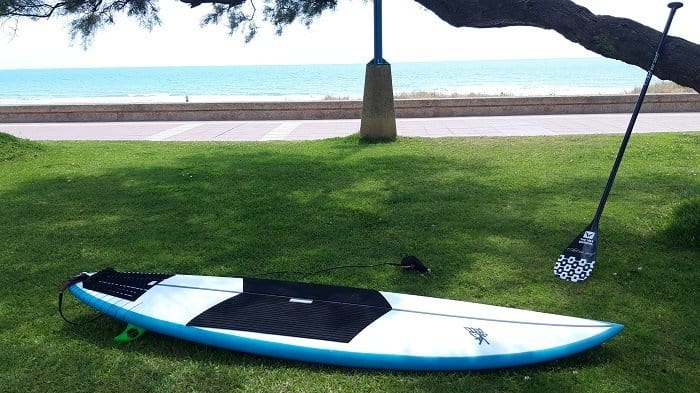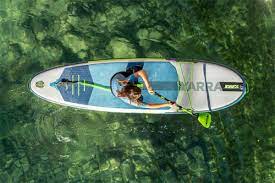Can we go paddling on a surfboard? Many people have asked this question, and the answer to this one is yes! You can use a surfboard as a stand up paddleboard and vice versa. If you’re interested in getting started with stand up paddling, you may wonder if you can use a surfboard as a paddle board. Perhaps you have got an old surfboard lying around, or you’re already a surfer and would prefer to give SUP a try before buying an expensive paddle board.
In this blog, we will discuss the differences between paddle boarding and surfing and how to use a surfboard as a paddle board.
Keep reading for more information!
Paddleboarding is a fantastic way to enjoy the water tides, whether you’re surfing or cruising. And, if you’ve a surfboard, you can give paddle boarding a try without having to buy a new paddle board. For one most important thing, you’ll need to be cautious of your balance. The good part is that you can use the surfboard’s fins to help you stay well-balanced and upright.
What is the difference between a surfboard and a paddleboard?
First, know the difference between a surfboard and a paddleboard.
A surfboard is a long, narrow board that riders use for riding waves. Typically, they are made of foam or fiberglass and feature a smooth bottom that helps the surfers glide seamlessly across the water. There are many brands out there that manufacture surfboards. One such name is Liquid Shredder. The brand offers the best way to enjoy the most out of your riding experiences. Apply Liquid Shredder Coupon Code to save big on high-quality surfboards and paddleboards.
On the other hand, Paddleboards are much broader and thicker than surfboards. They are generally shorter in length, making them easier to maneuver. Paddleboards are sometimes used for racing or recreational purposes. Most people enjoy paddling in flat water like lakes and ponds.
While both types of boards can be used for paddling in the ocean, paddleboards are usually ideal for calm waters because of their lower likelihood of tumbling over.
Although paddle boards are similar to surfboards in order of sizing, their dimensions and proportions are normally quite different. When riding a paddleboard, the goal is to balance upright on the board and use a paddle for moving. While on a surfboard, you expend most of your time lying down and paddling with your hands in the water.
For this reason, a paddleboard generally has more volume as compared to a surfboard and is usually wider, longer, and thicker. The additional volume, width, and thickness give the paddleboard the extra stability required to stand on it even at low speed.
Therefore, using a surfboard as a paddle board is a challenging task as most surfboards have low volume; they’re not built with stand up paddling in mind.
Let’s go a bit deeper and check out the differences between a stand up paddleboard and a surfboard, and determine whether or not using a surfboard as a paddleboard can be a viable option.
Paddleboard vs. Surfboard: Which is better?
#1) Paddleboards have more flotation than surfboards
Paddleboards are built to hold the full weight capacity of a person as they are standing on the board. This means SUP must have enough flotation to prevent them from sinking under the paddler. The higher the foam core is, the more flotation a paddle board will have.
A shortboard surfboard usually has 23-24 liters of foam volume. However, a longboard with 85 liters of foam will also be prone to sinking if stood on for a longer duration or on flat water, making balancing tough for all but the advanced riders.
#2) Surfboards and Paddleboards are built to different dimensions
Usually, SUPs are wider and thicker as compared to surfboards of the same length. This is caused by the larger foam volume and is designed to create more stability. Paddleboards start at 4 inches thick, while surfboards can be two inches depending on the weight & size of the rider.
The differences in their dimensions and shape are what create the differences in their balance and maneuverability. Surfboards have a smooth, waxed bottom to create a grip that lets the surfer stand with balance. Paddleboards, on the other hand, come with a textured surface to help prevent sliding.
#3) They have differently shaped rockers
The rocker is the curve in a surfboard or paddle board from the nose to the tail that gives it a banana shape. The function of this rocker curve is to help the board fit the curvature of the wave. Both paddle boards and surfboards are constructed with a rocker.

Surfboards usually have more rocker that allows them to drive into the wave. This helps the board cling to the wave as the user maneuvers over the wave surface. The rocker will help the surfer move faster and change directions quickly. Skilled riders will require more rocker curves for stepper waves and surf in the high curl of the wave.
On the contrary, paddleboards have a long flat curve that is suitable for gliding. This can increase efficiency so that less effort is needed for paddling. Furthermore, it also means that the stand up paddle boards perform better on flat water, such as a lake or open ocean.
Conversely, can you surf on a paddleboard?
Surfing on a stand up paddle board is definitely easier than paddling on a surfboard. Since a paddleboard is usually more floatable than a traditional surfboard, hand paddling and getting into the water on a SUP is easy. The only warning sign is if the SUP is very wide, for instance. over 30″; surfers having small arms may face a harder time paddling when lying down on the board.
Moreover, people with disabilities or injuries, as well as kids or older people, can take advantage of the additional buoyancy and volume of a stand up paddle board to learn to catch and enjoy smaller waves.
Conclusion
Paddleboarding is a way to enjoy the water, whether you’re surfing the waves or cruising on calm waters. And yes, you can surf on your stand up paddleboard! Paddleboards are usually more stable than surfboards, so they’re an excellent alternative for newbies or anyone who wants to enjoy extra stability while surfing.
You may be able to paddle on a longboard if you have balance skills. However, paddleboards generally have a lot more volume and a shape that is ideal for paddling on flat water while delivering maneuverability for quick turns in waves.

